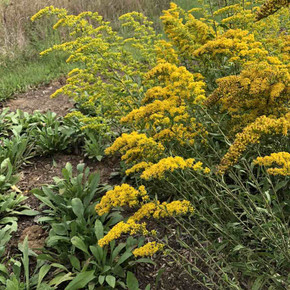

Please note your preferred ship date/week in the "Order Comments" section at checkout.
Otherwise, please allow 1-3 weeks to receive your order.
See the "Shipping" page under "Company Information" for our default ship dates based on hardiness zone.
We are unable to ship to any US Territories, AK, AZ, CA, CO, HI, ID, MT, NM, NV, OR, UT, WA, or WY
Originally named Aster ptarmicoides, this plant was re-named to Solidago ptarmicoides in 1981 as a result of research by two botanists, Brouillet and Semple, who realized that this plant belongs to the goldenrod family. For more confusion, another often-used name is Oligoneuron ptarmicoides.
Anyhow, this plant has aster-like, small, pale white flowers in clusters and narrow goldenrod-like leaves. So, we can say it is somewhere between the two, and that's why it could become a parent of the new hybrid perennial called Solidaster (Solidaster luteus).
The value of this wildflower is that it's late flowering, provides good pollinator support, grows low in clumps and has an extremely high tolerance to dry and poor soils! It is also tolerant to heat, humidity, and drought.
Picture copyright : BotBln, Commons Wikipedia
Blooming Time: August to October
Size: 1-2' tall and wide (depending on the moisture and fertility of the soil)
USDA Zones: 3 to 8
Culture: full sun and drained soils are best, but will tolerate half-shade and even moist soil if it's drained.
Moisture Needs: dry to medium
Origin: Native to Central North America, see the USDA distribution map.
Deer/Rabbit Resistant: yes / probably
Attracts Butterflies or Pollinators: native bees, honey bees, butterflies
Attracts Hummingbirds: no
Pot Size: 3.5" x 4" perennial pot
Originally named Aster ptarmicoides, this plant was re-named to Solidago ptarmicoides in 1981 as a result of research by two botanists, Brouillet and Semple, who realized that this plant belongs to the goldenrod family. For more confusion, another often-used name is Oligoneuron ptarmicoides.
Anyhow, this plant has aster-like, small, pale white flowers in clusters and narrow goldenrod-like leaves. So, we can say it is somewhere between the two, and that's why it could become a parent of the new hybrid perennial called Solidaster (Solidaster luteus).
The value of this wildflower is that it's late flowering, provides good pollinator support, grows low in clumps and has an extremely high tolerance to dry and poor soils! It is also tolerant to heat, humidity, and drought.
Picture copyright : BotBln, Commons Wikipedia
Blooming Time: August to October
Size: 1-2' tall and wide (depending on the moisture and fertility of the soil)
USDA Zones: 3 to 8
Culture: full sun and drained soils are best, but will tolerate half-shade and even moist soil if it's drained.
Moisture Needs: dry to medium
Origin: Native to Central North America, see the USDA distribution map.
Deer/Rabbit Resistant: yes / probably
Attracts Butterflies or Pollinators: native bees, honey bees, butterflies
Attracts Hummingbirds: no
Pot Size: 3.5" x 4" perennial pot
I bought these to use as a border along a rock garden with well draining soil. The plants arrived in great shape, and have thrived since I put them in the ground. I live in zone 6A, and have been watering them regularly due to having a much drier spring than normal.
